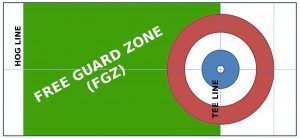
5 Rock Rule
The 5 rock rule will be in place for all WCF and RCCC competitions from the start of the 2018-19 curling season. It will also be used for Kinross Curling Trust competitions and the club’s committee have agreed that it should also be used in all our club competitions as well.
What Is It?
Under the five-rock rule, teams are not permitted to remove their opponent’s stones that are sitting in the free guard zone until five stones have been played in an end. Players can still hit the guards; they just aren’t allowed to knock them out of play.
This is a change to the previous rule in that the free guard zone was only is in effect for the first four stones.
Why Change?
This rule is being introduced to keep more stones in play and increase scoring opportunities thus producing a more interesting game. There should be fewer blank ends and early finishes.
The Rule
The Free Guard Zone (FGZ) is the area after the hog line, but before the house. The rocks in this area are in play, but cannot score unless advanced into the house. The RCCC rule book defines it as follows:
A stone that comes to rest between the tee line and the hog line at the playing end, and excluding the house, is deemed to be within an area designated as the FGZ. Also, stones that are in play, on or before the hog line, after striking stones in the FGZ, are deemed to be in the FGZ.

The 5 rock rule has been incorporated into the RCCC rule book as follows:
If, prior to the delivery of the sixth stone of an end, a delivered stone causes, either directly or indirectly, an opposition stone to be moved from the FGZ to an out-of-play position, then the delivered stone is removed from play, and any displaced stones are replaced to their original positions, by the non-offending team, to their positions prior to the violation taking place.
Affects on Strategy
The new rule will not change the strategy of all ends. Here is a brief description of how it might change the tactics:
Teams tied in the last end
The goal here is no different. The team with the hammer is trying to score, and the team without the hammer is trying to steal. The team with the hammer can start peeling stones with its second’s first stone, the same as always.
Teams with hammer and a lead in the game
The strategy probably will not change. Teams with the hammer and a lead in the game do not often play two corner guards thus taking the risk that they may give up a steal by ignoring other stones in the middle of the house.
Team with hammer is down in the game
This is where the biggest difference is likely to be seen. The team without the hammer cannot fully remove a stone with its second’s first stone, so when a team with the hammer is down it has the ability to throw two corner guards that cannot be fully removed from play immediately. This will often mean that the team without the hammer keeps its first three stones in play. It changes the mindset on how teams defend big leads; do they play freezes or tapbacks in order to protect, or do they still attempt to throw the big-weight peels to try to clean up multiple stones in play? What if they miss the first double peel and the team with hammer now has a stone frozen to theirs and another one behind a corner guard?
Teams will have to experiment to find what works best for them. How much risk are they willing to take on at various points in the game? How can their opposition force them to put more stones in play, even when they may not want to? There is no one easy way to defend; some teams may still try to hit their way out of ends, and others may go to an offensively-defensive approach based on their skill sets. No strategy right now is thought to be best practice. Everyone needs to work through the various ways that an end plays out to find out what works best for them.
Full Rules of Curling
If you would like to know the finer details of the rules of curling you can read more here.
Copyright © 2024 | MH Corporate basic by MH Themes